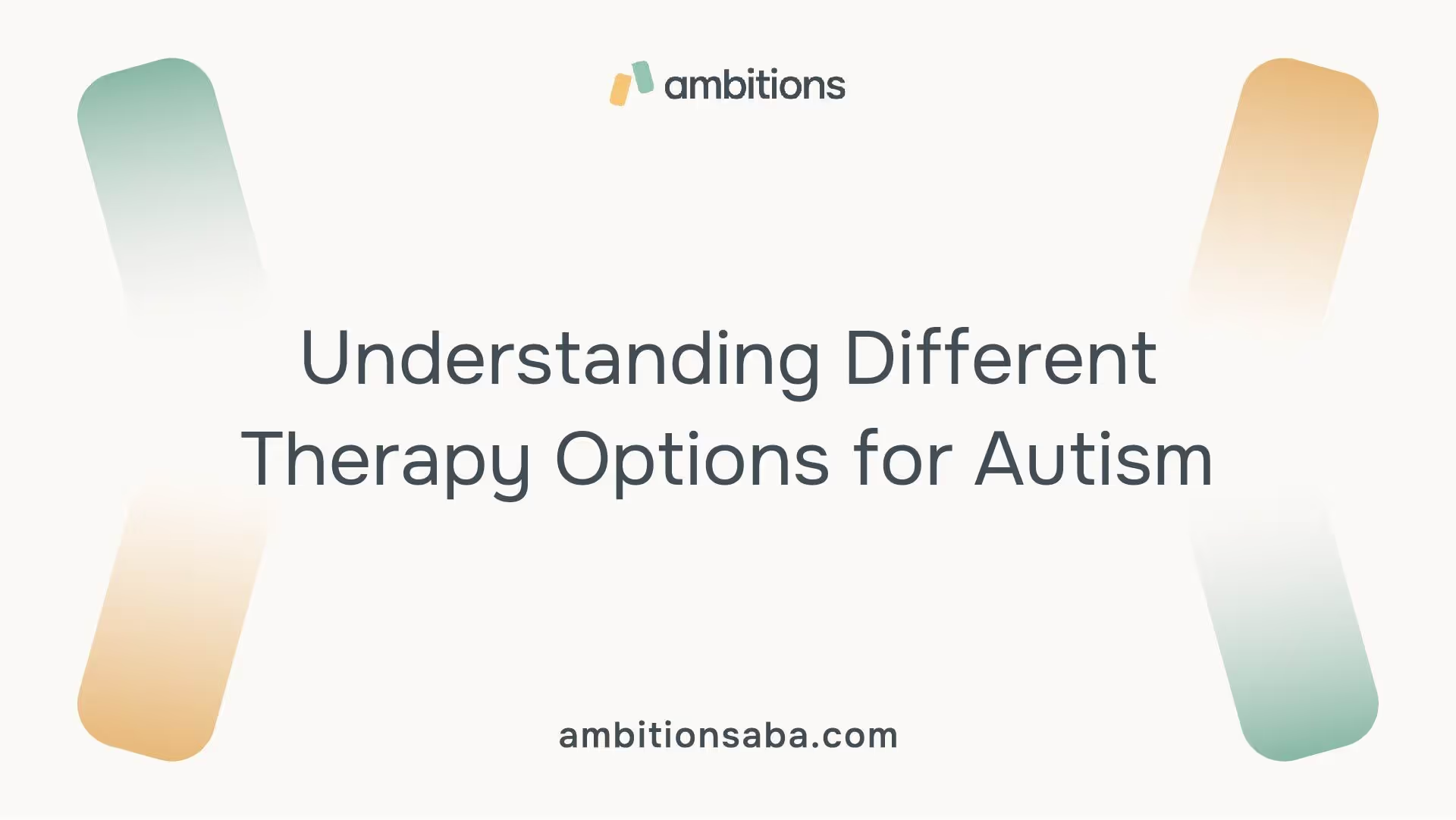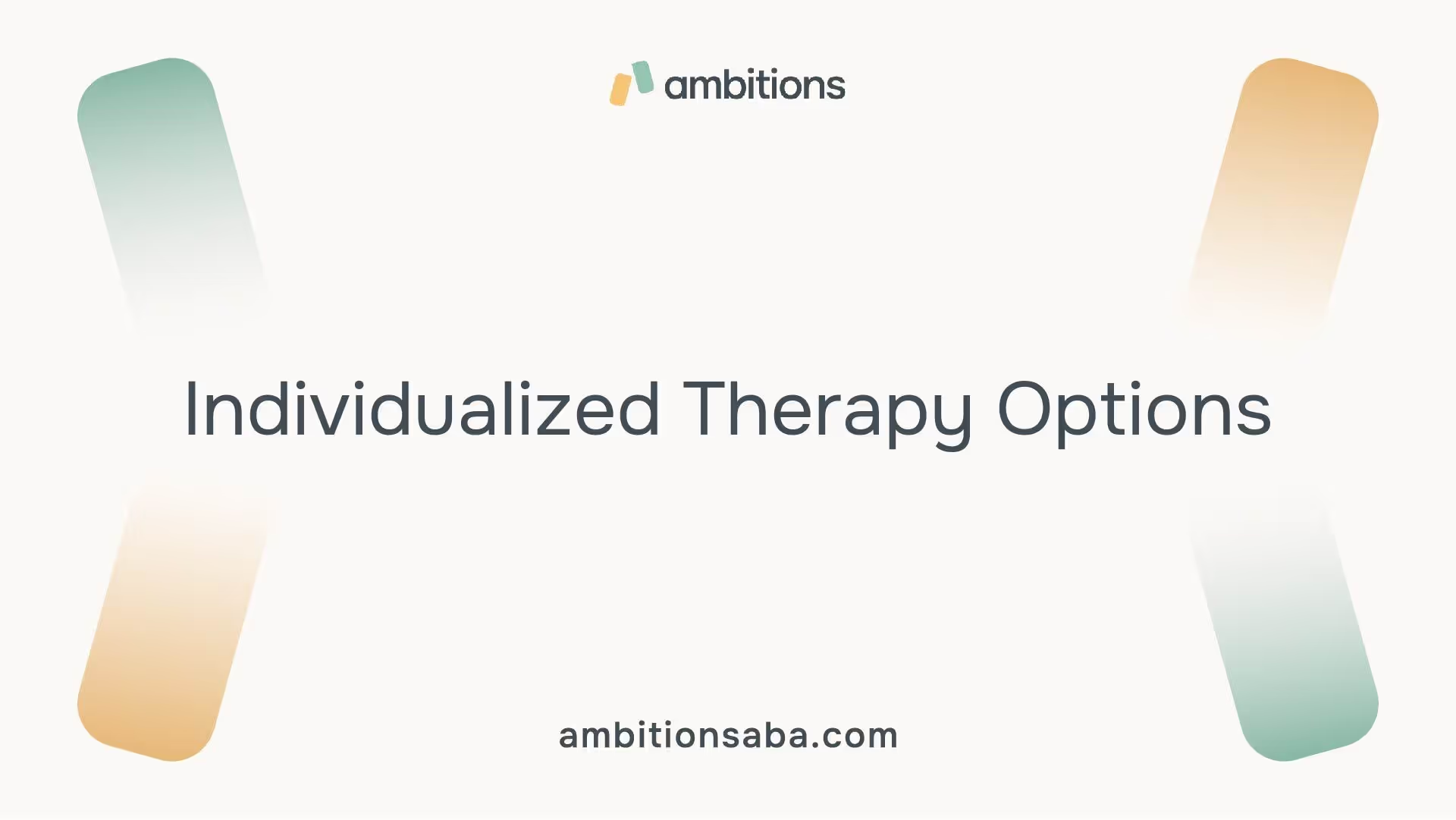Understanding Autism Therapy Options

Importance of Early Intervention
Early intervention plays a vital role in the development of children with autism spectrum disorder (ASD). Accessing therapy at an early age can significantly improve outcomes and skills. Children who receive early support are likely to develop better communication and social skills, increase their chances of success in school, and enhance their overall quality of life. Research indicates that early intervention can help leverage brain plasticity, providing children a better foundation for their growth. For more insights, explore the early intervention benefits in autism.
Benefits of Early InterventionDescriptionImproved Social SkillsHelps children engage with peers effectively.Enhanced CommunicationSupports verbal and nonverbal expression.Increased FlexibilityAids in adapting to changes and challenges.Better Academic PerformanceIncreases readiness for school settings.
Speech-Language Therapy Benefits
Speech-language therapy is highly beneficial for individuals with autism. It enhances communication abilities, focusing on both verbal and nonverbal skills. This form of therapy helps children engage more meaningfully with others. Strategies may include improving expressive language, understanding social cues, and developing conversational skills.
According to the NICHD, individuals with ASD often face challenges in communication. By addressing these issues through tailored speech-language therapy, they can build confidence and competence in social situations.
Key Benefits of Speech-Language TherapyDetailsImproved Verbal SkillsFocuses on expanding vocabulary and clarity in speech.Enhanced Nonverbal SkillsTeaches the use of gestures and facial expressions.Increased Social InteractionEncourages meaningful conversations with peers.
Explore more on how to support communication with children through our autism communication tips for caregivers.
Behavioral Therapy Approaches
Behavioral therapy is a commonly used method for managing autism. It aims to reinforce positive behaviors while reducing negative ones by implementing specific strategies. One of the most recognized approaches within this category is Applied Behavior Analysis (ABA). ABA involves monitoring a child's progress while enhancing their skills in a structured manner.
Behavioral management provides parents and therapists with strategies to address and reduce unwanted behaviors. This method includes both proactive and reactive techniques, ensuring that not only the problem behaviors decrease, but also that effective skills are taught and reinforced. According to the NICHD, tailored treatment is essential due to overlapping symptoms with other disorders like ADHD.
Behavioral Therapy ElementsDescriptionReinforcement StrategiesPositive reinforcement to encourage desired behaviors.Targeted InterventionsCustom approaches based on individual needs.Progress MonitoringRegular assessments to track improvements.
ABA therapy specifically focuses on promoting positive behaviors and can be adapted for various age groups and developmental stages. For more details on how ABA can benefit your child, visit how aba promotes positive behaviors.
Individualized Therapy Options

Finding the right therapy for children with autism is essential for their development. Individualized therapy options can cater to their unique needs, enhancing communication, social behavior, and overall well-being. Here, we’ll explore Applied Behavior Analysis (ABA), Cognitive Behavioral Therapy (CBT), and the benefits of Occupational Therapy.
Applied Behavior Analysis (ABA)
Applied Behavior Analysis (ABA) therapy is often regarded as the gold standard in autism treatment. It addresses a wide range of skills such as communication, socialization, and reducing challenging behaviors through data-driven approaches. This makes it highly individualized to cater to each child's specific needs.
Several approaches within ABA are commonly utilized to address Autism Spectrum Disorder (ASD). These include:
ABA ApproachDescriptionDiscrete Trial Training (DTT)Focuses on teaching skills through a structured series of steps.Natural Language Acquisition (NLA)Teaches communication in a naturalistic environment.Functional Communication Training (FCT)Reinforces communication as a tool to reduce challenging behaviors.
Through consistent implementation and monitoring, parents can observe improvements in their child's behaviors and skills. Check out the impact of ABA therapy on families for more insights.
Cognitive Behavioral Therapy (CBT)
Cognitive Behavioral Therapy (CBT) is effective for individuals with autism who experience anxiety, obsessive behaviors, or depression. It offers practical tools to manage emotions, reduce anxiety, and develop coping strategies. CBT ultimately teaches emotional regulation and improves behavior.
This therapy focuses on the following principles:
CBT PrincipleDescriptionCognitive RestructuringHelps individuals identify and challenge negative thought patterns.Coping StrategiesTeaches skills to handle stressful situations effectively.Exposure TherapyGradually exposes individuals to anxiety-inducing situations to reduce fear.
Incorporating CBT into an overall treatment plan can significantly enhance your child’s ability to navigate daily challenges. Additional resources like autism communication tips for caregivers can support this process.
Occupational Therapy Benefits
Occupational therapy plays a vital role for individuals with autism, particularly those who struggle with sensory processing disorders, fine and gross motor skills, and daily living activities. Occupational therapists focus on enhancing independence and overall quality of life.
Key aspects of occupational therapy include:
OT Focus AreaDescriptionSensory ProcessingHelps individuals cope with sensory overload and differences.Fine Motor SkillsDevelops skills needed for tasks like writing and buttoning clothing.Daily Living SkillsTeaches essential self-care tasks, like feeding and dressing.
This therapy empowers children to accomplish everyday tasks and build confidence. Learning about the benefits of developing life skills in autism can further enhance outcomes.
Each therapy option offers unique benefits and can be tailored to suit the needs of children with autism. Parents should consider these individualized approaches when exploring the best path forward for their child.
Complementary Therapy Approaches
In addition to traditional therapies like ABA, there are several complementary options available for children with autism. These approaches can provide additional benefits and enhance the overall development of the child. This section discusses the effectiveness of music therapy, dietary interventions, and sensory therapy.
Music Therapy Effectiveness
Music therapy has shown to significantly benefit children with autism spectrum disorder (ASD). Research indicates that it may improve skills in social interaction, verbal communication, initiating behavior, and social-emotional reciprocity, creating a more positive environment for learning and development. Engaging with music not only makes therapy enjoyable but also encourages children to express themselves in ways they may find challenging in other settings.
Benefits of Music Therapy for ASDImproved social interactionsEnhanced verbal communicationIncreased initiation of behaviorsStrengthened emotional connections
Dietary Interventions
Dietary interventions have gained attention for their potential positive effects on children with ASD. Supplements such as high-dose pyridoxine (vitamin B6) and magnesium are reported to improve social interactions, communication, and reduce stereotyped behaviors. Omega-3 long-chain fatty acids also play a crucial role in brain development and cognitive function, making them a consideration for families exploring dietary changes.
Dietary SupplementsPotential BenefitsVitamin B6Improved social interactions, communicationMagnesiumReduced repetitive behaviorsOmega-3 Fatty AcidsBrain development support
Sensory Therapy Benefits
Sensory therapy aims to assist children with autism in better regulating and responding to sensory input. It reduces sensory-related challenges and enhances overall functioning. Sensory activities can help children learn to manage their reactions to various stimuli, ultimately fostering a more comfortable daily experience.
Sensory Therapy BenefitsBetter sensory regulationImproved response to sensory inputEnhanced daily functioning
These complementary therapy approaches, including music therapy, dietary changes, and sensory therapy, can be valuable additions to a comprehensive treatment plan. Each child's needs are unique, so consulting with professionals in the field can help parents find the most beneficial strategies for their child. For more insights on autism, consider exploring our resources on autism communication tips for caregivers or managing autism meltdowns effectively.
Specialized Treatment Plans
Specialized treatment plans for children with autism are essential in providing tailored support that addresses their unique needs. A comprehensive approach ensures that various aspects of development are targeted, allowing for effective progress.
Comprehensive Therapy Approaches
A comprehensive autism treatment plan may encompass a range of therapies, such as speech therapy, physical therapy, and occupational therapy. Each of these therapies addresses specific challenges faced by a child, including language development, motor skills, and daily functioning. This holistic view emphasizes the importance of personalized treatment plans to meet individual needs.
The table below summarizes potential therapies included in a comprehensive treatment approach:
Therapy TypeFocus AreaTypical GoalsSpeech TherapyLanguage developmentImprove communication skillsPhysical TherapyMotor skillsEnhance body coordination and strengthOccupational TherapyDaily functioning and self-care skillsFoster independence in daily tasksBehavioral TherapyBehavior modificationPromote positive behaviors and social skills
Various specialists work with individuals with autism to implement these comprehensive treatment plans. This may include audiologists, speech-language pathologists (SLPs), psychologists, and special educators, among others.
Therapy Personalization
Tailoring therapy to the individual child is key to successful outcomes. Personalization involves assessing each child's specific needs and strengths, adjusting approaches to maximize effectiveness. For instance, early intervention that combines various therapies can help children develop age-appropriate language, social, and behavior skills. This collaborative effort among specialists may include SLPs, occupational therapists, and psychologists.
Most children with autism benefit from targeted treatment of language deficits and behavior, which may include:
Using this tailored approach, families can navigate the complexities of autism therapy more effectively. Resources like navigating healthcare for autism and choosing autism resources wisely can be invaluable in selecting appropriate therapies for their children.
Future Research and Considerations
Continuous Improvement
The field of autism therapy is constantly evolving. Ongoing research is essential to refine existing therapeutic approaches and develop new strategies that can enhance the quality of life for individuals with autism spectrum disorder (ASD). Continuous monitoring of therapy effectiveness ensures that clinicians can adapt practices based on new findings and feedback from families. Implementing evidence-based practices can lead to therapy personalization, making interventions more effective for the unique needs of each child.
As new studies emerge, it’s important for parents to stay informed about the latest advancements in therapy options. This proactive approach will not only assist them in making educated decisions but also help them understand the potential benefits of different therapies, including how ABA promotes positive behaviors.
AspectFocusResearch AreaNew interventionsObjectiveValidate therapy effectivenessTargetAdapt practices for individual needs
Emerging Therapies
Emerging therapies for autism include a variety of innovative approaches, ranging from technology-assisted therapies to complementary and alternative medicine (CAM). Studies indicate that the use of CAM therapies among children with ASD can range from 28% to 51% in different cohorts, with some reporting lifetime use as high as 71% in the United States. These therapies often aim to address specific challenges faced by individuals with autism, such as communication and sensory sensitivities.
Parents are encouraged to research any new therapies and consider how they could potentially fit into their child’s overall treatment plan. Collaborating with professionals like occupational therapists who can create specialized sensory diets (Autism.org.uk) can also improve focus and regulation.
Support Systems for Families
Support systems are vital for families managing the challenges of autism. These systems can include access to specialists such as speech-language pathologists (SLPs), psychologists, and job coaches who provide comprehensive support throughout an individual’s life [4]. Families should also consider support groups that can connect them with other parents facing similar experiences.
Having a strong support network can assist families in navigating the complexities of autism therapy options. These connections can help in sharing valuable insights, strategies, and resources. Parents can benefit from understanding autism communication tips for caregivers to improve interactions and ensure effective communication with their children.
For personalized support, families can explore community resources and specialized programs that promote independence, life skills, and socialization tips for kids with autism. This holistic approach empowers families to make informed choices about the best therapy options for their child.
References
[2]:
[3]:
[4]:
[5]:
[6]:



